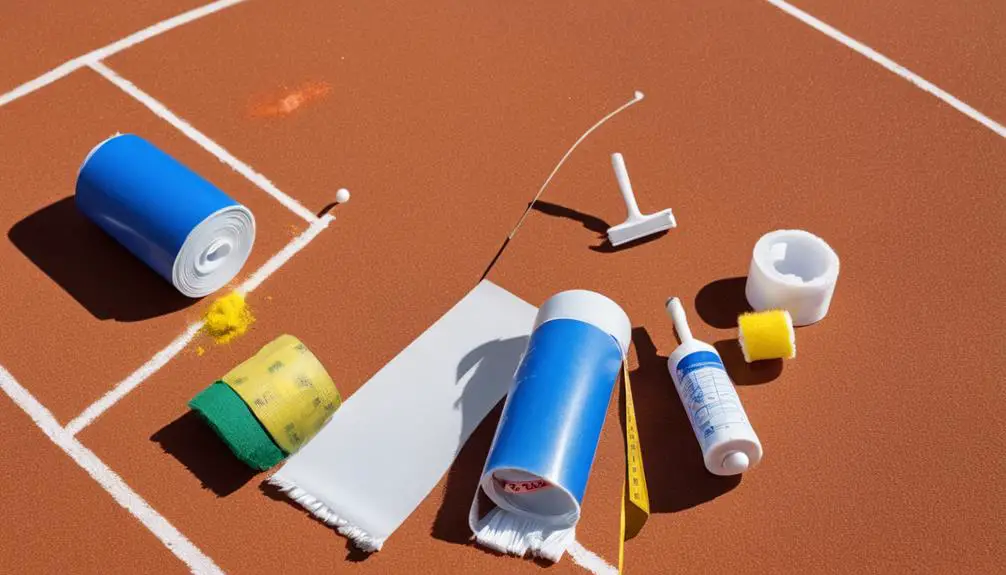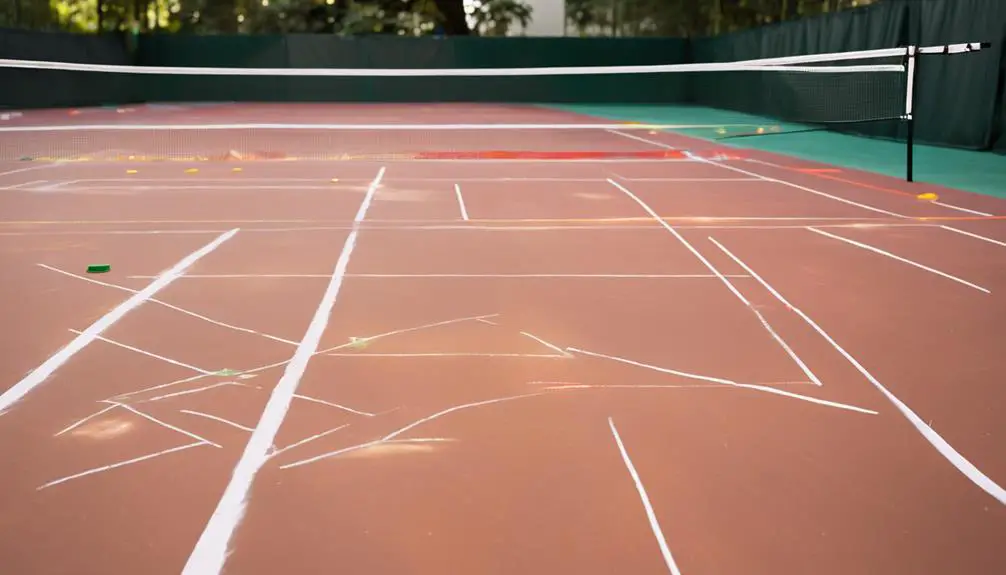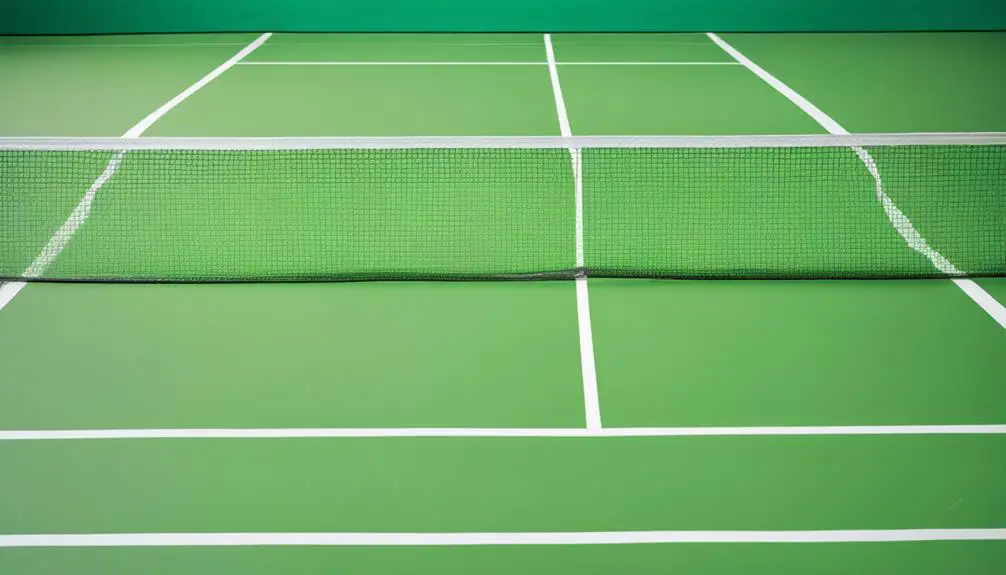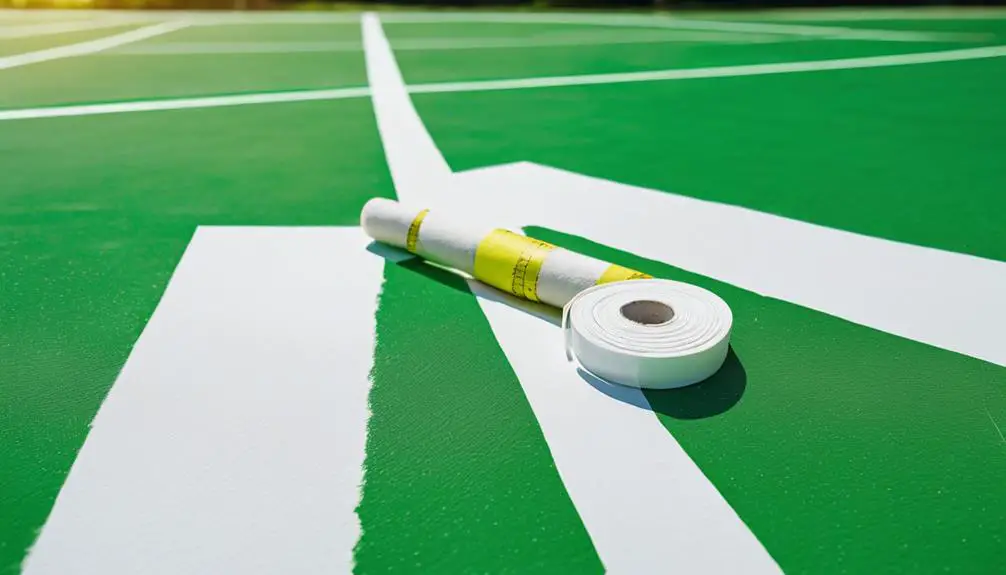To create badminton court lines, start by gathering tools like measuring tape, chalk line, and appropriate paint or tape. Measure the dimensions accurately—20ft by 44ft for doubles, 17ft by 44ft for singles. Mark lines using a straight edge for precision; they should be 40mm wide. Choose high-contrast colors like white or yellow for visibility. For outdoor courts, use weather-resistant paint and consider a protective sealant. Regularly inspect and maintain the lines to guarantee clarity and durability. If you implement these practices effectively, you’ll establish a clear and long-lasting badminton court setup. More details await you for a seamless execution.
Tools and Materials Needed

Before you begin marking the lines on your badminton court, it’s essential to gather the right tools and materials to guarantee accuracy and durability. Start by selecting the appropriate line types for your court. Typically, you’ll need a combination of white or yellow paint or tape specifically designed for sports surfaces, as these colors provide visibility against various court surfaces.
Next, you’ll need fundamental measuring tools. A measuring tape, preferably 50 feet or longer, will help you accurately measure your court dimensions. A chalk line tool can assist in making straight lines, while a level will assure your lines are consistent and even. For marking the lines, consider using a paint applicator or a roller, which allows for a smooth application and less mess.
Don’t forget protective gear. Gloves will keep your hands clean while applying paint, and knee pads can protect your knees if you’ll be working close to the ground. Also, if you’re working on an outdoor court, it’s best to check the weather conditions to confirm a dry surface for best adhesion.
Lastly, think about safety. A well-ventilated area is important if you’re using paint indoors. Proper preparation will guarantee that your badminton court looks professional and lasts through many matches, giving you the freedom to enjoy the game without worrying about the court’s condition.
Measuring the Court Dimensions
To accurately measure the badminton court dimensions, you’ll first want to familiarize yourself with the standard measurements: a full-size court measures 20 feet wide and 44 feet long for doubles matches, while singles courts are slightly narrower at 17 feet wide. Understanding these dimensions is essential for guaranteeing your court meets official standards.
Next, you’ll need to choose the right measurement techniques. Using a tape measure is the most common and straightforward method. Start at one corner of the court and extend the tape to reach the opposite corner, making sure it’s straight and level. Mark the points where measurements are taken for clarity. It’s also helpful to use chalk or a marker to outline your initial measurements.
Here’s a quick reference table for your convenience:
| Court Type | Width (feet) | Length (feet) |
|---|---|---|
| Doubles | 20 | 44 |
| Singles | 17 | 44 |
When measuring, consider the playing surfaces and any potential obstructions. Confirm your measurements account for any differences in terrain, as these can affect your final dimensions. Once you’ve verified the measurements, double-check to make sure everything aligns with the required specifications. This attention to detail will set the stage for accurate court marking and enhance your playing experience.
Choosing the Right Marking Method

How can you guarantee your badminton court lines are both visible and durable? Choosing the right marking method is essential. You’ll want to take into account different marking techniques that suit your court’s surface and intended usage. For indoor courts, using specialized court marking paint is often the best option. This paint adheres well to wood or synthetic surfaces and remains visible even after extensive play. If you’re marking an outdoor court, opt for durable outdoor paint or chalk that can withstand weather conditions.
Next, think about line colors. The International Badminton Federation recommends using white or yellow for the lines. These colors provide great contrast against most surfaces, making them easily visible to players. Verify that your chosen color complies with the regulations if you plan to host official matches.
Another option is using adhesive court marking tape, which can be particularly useful if you need a temporary solution or plan to reposition lines frequently. While tape can be less durable than paint, it allows for flexibility in court design and is easy to apply.
Marking the Court Lines
Typically, marking the court lines requires careful attention to detail to confirm accuracy and visibility. First, gather your court line materials, which can include specialized line paint, tape, or chalk. Each material has its pros and cons, so choose based on the surface type and your long-term maintenance plans. For example, outdoor courts may benefit from weather-resistant paint, while indoor courts often use tape for easy removal.
Next, decide on your line marking techniques. If you’re using paint, verify you have a straight edge and measuring tape to outline your lines. Measure and mark the dimensions of the court according to official badminton regulations. You’ll want to confirm the lines are 40mm wide and clearly define the boundaries of the playing area.
For a clean finish, apply the paint in consistent strokes, keeping the line width uniform. If you’re using tape, make certain the surface is clean and dry before applying for the best adhesion. Lay the tape down firmly and press out any bubbles to maintain a smooth surface.
If you’re marking multiple courts, consider using a stencil or a chalk line for consistency. This technique allows you to replicate the dimensions accurately across different courts. Remember, the goal is to create clearly defined lines that enhance the gameplay experience, so take your time, double-check your measurements, and confirm your lines are straight and evenly spaced. Happy marking!
Ensuring Line Visibility

After marking the court lines, verifying their visibility is vital for facilitating fair play and enhancing the overall experience. The colors you choose for your lines can greatly affect how well they stand out against the court surface. It’s essential to select line colors that contrast with the court background. For instance, if you have a dark surface, opt for bright colors like white or yellow.
Moreover, weather conditions can impact visibility. If you’re playing outdoors, consider using weather-resistant paint to maintain clarity. Sunlight can bleach colors over time, and rain can wash away less durable paints. Regularly inspect the lines after adverse weather to confirm they remain visible.
To help you understand the best practices for confirming line visibility, here’s a simple table:
| Factor | Recommended Action | Notes |
|---|---|---|
| Line Colors | Use contrasting colors | White or yellow for dark surfaces; black for light surfaces |
| Weather Conditions | Use weather-resistant paint | Protects against fading and water damage |
| Regular Maintenance | Inspect after rain/sunlight | Touch up lines as needed for ideal visibility |
Maintenance of Court Lines
Regular maintenance of court lines is essential to guarantee they remain clear and functional throughout the playing season. Neglecting this aspect can lead to faded lines, which compromises gameplay and player safety. To promote line durability and peak performance, consider the following seasonal maintenance tips:
- Inspect Regularly: Check the lines before and after each use. Look for any signs of wear, fading, or damage. Early detection allows for timely repairs.
- Clean Thoroughly: Use a soft-bristle broom or vacuum to remove dust and debris. For deeper cleaning, a mild detergent mixed with water can be applied. Rinse well to prevent any slippery residue.
- Repaint as Needed: Depending on wear and tear, you may need to repaint the lines at least once per season. Choose a high-quality paint specifically designed for sports courts to promote lasting visibility and durability.
- Protect from Elements: If your court is outdoors, consider using a protective sealant. This can help shield the lines from rain, UV rays, and other environmental factors that could lead to deterioration.
Tips for Long-lasting Lines

To guarantee your badminton court lines remain vibrant and effective throughout the season, implementing a few strategic measures can make a significant difference. Start with your line color selection; choose bright, high-contrast colors that stand out against the court surface. Opting for colors that resist fading, such as fluorescent yellow or white, guarantees better visibility and longevity.
Next, consider weather considerations if your court is outdoors. Regular exposure to sunlight, rain, and temperature fluctuations can degrade line quality. To mitigate this, apply a protective sealant over the lines after painting them. This not only enhances durability but also provides a barrier against UV rays and moisture.
Additionally, timing your line application is vital. Ideally, paint the lines during periods of dry weather, avoiding days with high humidity or impending rain. This allows the paint to adhere properly and dry thoroughly, reducing the risk of peeling or fading.
Regular maintenance is also key to longevity. Inspect the lines periodically, and touch up any worn or faded areas promptly. Keeping the court clean helps maintain line visibility, so sweep or wash the surface regularly to eliminate dirt and debris.
Lastly, encourage players to respect the court by avoiding unnecessary wear from heavy foot traffic outside designated areas. By following these tips, you’ll guarantee your badminton court lines remain clear, vibrant, and ready for play throughout the season.
Frequently Asked Questions
What Is the Best Surface for a Badminton Court?
When choosing a badminton court surface, consider court surface materials like wood for indoor play, offering excellent grip, versus synthetic options for outdoor settings. Each surface impacts your performance and the game’s overall enjoyment.
Can I Use Tape Instead of Paint for Court Lines?
Using tape for court lines can be like putting a bandage on a wound; it’s a quick fix. Guarantee the tape’s durability and proper tape application for the best results, but consider long-term solutions.
How Often Should I Repaint the Court Lines?
You should repaint the court lines every 6-12 months, depending on line maintenance and weather impact. Regular checks will help you gauge wear, ensuring your court remains safe and visually appealing for players.
Are There Specific Colors Required for Badminton Lines?
Yes, there are specific colors for badminton lines. You should use white or yellow for high line visibility and ideal color contrast against the court surface, ensuring players can easily see the boundaries during play.
Can Outdoor Courts Use the Same Marking Methods as Indoor Courts?
When considering court creation, you can certainly adapt indoor marking techniques for outdoor use, but remember outdoor considerations like weather resistance and durability are essential for lasting lines. Choose materials that withstand the elements effectively.




